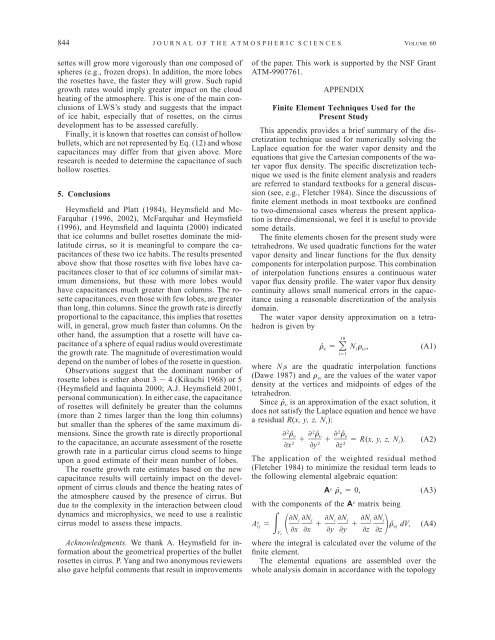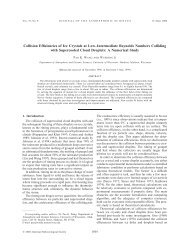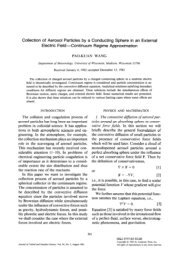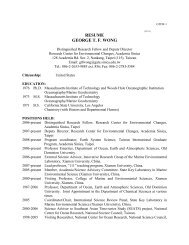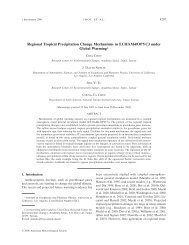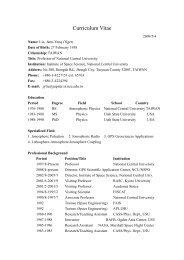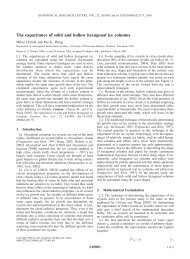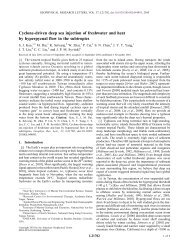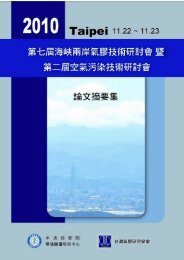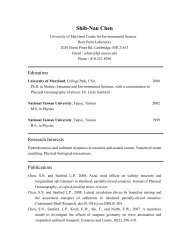The Capacitance of Rosette Ice Crystals - University of Wisconsin ...
The Capacitance of Rosette Ice Crystals - University of Wisconsin ...
The Capacitance of Rosette Ice Crystals - University of Wisconsin ...
Create successful ePaper yourself
Turn your PDF publications into a flip-book with our unique Google optimized e-Paper software.
844 JOURNAL OF THE ATMOSPHERIC SCIENCES<br />
VOLUME 60<br />
settes will grow more vigorously than one composed <strong>of</strong><br />
spheres (e.g., frozen drops). In addition, the more lobes<br />
the rosettes have, the faster they will grow. Such rapid<br />
growth rates would imply greater impact on the cloud<br />
heating <strong>of</strong> the atmosphere. This is one <strong>of</strong> the main conclusions<br />
<strong>of</strong> LWS’s study and suggests that the impact<br />
<strong>of</strong> ice habit, especially that <strong>of</strong> rosettes, on the cirrus<br />
development has to be assessed carefully.<br />
Finally, it is known that rosettes can consist <strong>of</strong> hollow<br />
bullets, which are not represented by Eq. (12) and whose<br />
capacitances may differ from that given above. More<br />
research is needed to determine the capacitance <strong>of</strong> such<br />
hollow rosettes.<br />
5. Conclusions<br />
Heymsfield and Platt (1984), Heymsfield and Mc-<br />
Farquhar (1996, 2002), McFarquhar and Heymsfield<br />
(1996), and Heymsfield and Iaquinta (2000) indicated<br />
that ice columns and bullet rosettes dominate the midlatitude<br />
cirrus, so it is meaningful to compare the capacitances<br />
<strong>of</strong> these two ice habits. <strong>The</strong> results presented<br />
above show that those rosettes with five lobes have capacitances<br />
closer to that <strong>of</strong> ice columns <strong>of</strong> similar maximum<br />
dimensions, but those with more lobes would<br />
have capacitances much greater than columns. <strong>The</strong> rosette<br />
capacitances, even those with few lobes, are greater<br />
than long, thin columns. Since the growth rate is directly<br />
proportional to the capacitance, this implies that rosettes<br />
will, in general, grow much faster than columns. On the<br />
other hand, the assumption that a rosette will have capacitance<br />
<strong>of</strong> a sphere <strong>of</strong> equal radius would overestimate<br />
the growth rate. <strong>The</strong> magnitude <strong>of</strong> overestimation would<br />
depend on the number <strong>of</strong> lobes <strong>of</strong> the rosette in question.<br />
Observations suggest that the dominant number <strong>of</strong><br />
rosette lobes is either about 3 4 (Kikuchi 1968) or 5<br />
(Heymsfield and Iaquinta 2000; A.J. Heymsfield 2001,<br />
personal communication). In either case, the capacitance<br />
<strong>of</strong> rosettes will definitely be greater than the columns<br />
(more than 2 times larger than the long thin columns)<br />
but smaller than the spheres <strong>of</strong> the same maximum dimensions.<br />
Since the growth rate is directly proportional<br />
to the capacitance, an accurate assessment <strong>of</strong> the rosette<br />
growth rate in a particular cirrus cloud seems to hinge<br />
upon a good estimate <strong>of</strong> their mean number <strong>of</strong> lobes.<br />
<strong>The</strong> rosette growth rate estimates based on the new<br />
capacitance results will certainly impact on the development<br />
<strong>of</strong> cirrus clouds and thence the heating rates <strong>of</strong><br />
the atmosphere caused by the presence <strong>of</strong> cirrus. But<br />
due to the complexity in the interaction between cloud<br />
dynamics and microphysics, we need to use a realistic<br />
cirrus model to assess these impacts.<br />
Acknowledgments. We thank A. Heymsfield for information<br />
about the geometrical properties <strong>of</strong> the bullet<br />
rosettes in cirrus. P. Yang and two anonymous reviewers<br />
also gave helpful comments that result in improvements<br />
<strong>of</strong> the paper. This work is supported by the NSF Grant<br />
ATM-9907761.<br />
APPENDIX<br />
Finite Element Techniques Used for the<br />
Present Study<br />
This appendix provides a brief summary <strong>of</strong> the discretization<br />
technique used for numerically solving the<br />
Laplace equation for the water vapor density and the<br />
equations that give the Cartesian components <strong>of</strong> the water<br />
vapor flux density. <strong>The</strong> specific discretization technique<br />
we used is the finite element analysis and readers<br />
are referred to standard textbooks for a general discussion<br />
(see, e.g., Fletcher 1984). Since the discussions <strong>of</strong><br />
finite element methods in most textbooks are confined<br />
to two-dimensional cases whereas the present application<br />
is three-dimensional, we feel it is useful to provide<br />
some details.<br />
<strong>The</strong> finite elements chosen for the present study were<br />
tetrahedrons. We used quadratic functions for the water<br />
vapor density and linear functions for the flux density<br />
components for interpolation purpose. This combination<br />
<strong>of</strong> interpolation functions ensures a continuous water<br />
vapor flux density pr<strong>of</strong>ile. <strong>The</strong> water vapor flux density<br />
continuity allows small numerical errors in the capacitance<br />
using a reasonable discretization <strong>of</strong> the analysis<br />
domain.<br />
<strong>The</strong> water vapor density approximation on a tetrahedron<br />
is given by<br />
10<br />
i i<br />
i1<br />
ˆ N , (A1)<br />
where N i s are the quadratic interpolation functions<br />
(Dawe 1987) and i are the values <strong>of</strong> the water vapor<br />
density at the vertices and midpoints <strong>of</strong> edges <strong>of</strong> the<br />
tetrahedron.<br />
Since ˆ is an approximation <strong>of</strong> the exact solution, it<br />
does not satisfy the Laplace equation and hence we have<br />
a residual R(x, y, z, N i ):<br />
2 2 2<br />
ˆ ˆ ˆ <br />
R(x, y, z, N i). (A2)<br />
2 2 2<br />
x y z<br />
<strong>The</strong> application <strong>of</strong> the weighted residual method<br />
(Fletcher 1984) to minimize the residual term leads to<br />
the following elemental algebraic equation:<br />
Ae<br />
ˆ 0,<br />
(A3)<br />
with the components <strong>of</strong> the A e matrix being<br />
Ni Nj Ni Nj Ni N<br />
e<br />
j<br />
Aij ˆ j<br />
<br />
<br />
dV, (A4)<br />
x x y y z z<br />
V e<br />
where the integral is calculated over the volume <strong>of</strong> the<br />
finite element.<br />
<strong>The</strong> elemental equations are assembled over the<br />
whole analysis domain in accordance with the topology


